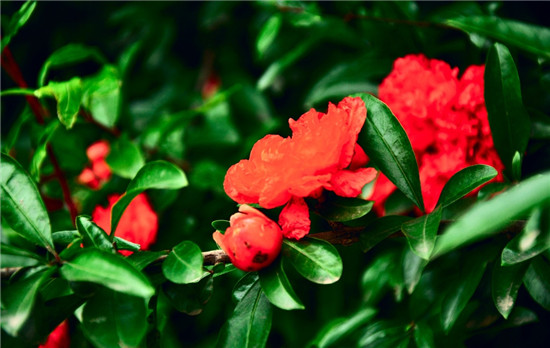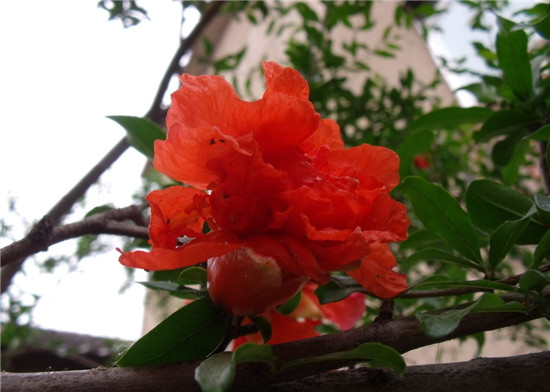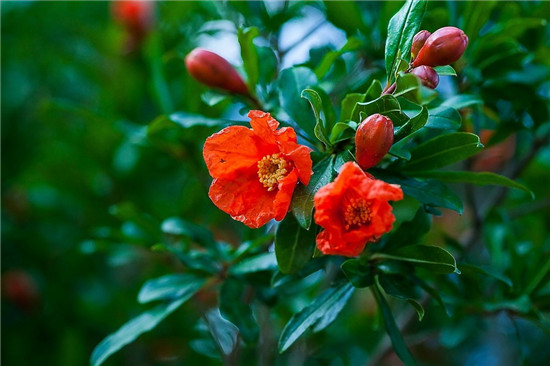What are the functions and effects of pomegranate flowers?
We all know that pomegranate flowers can be watched and tasted when they are ripe. In fact, pomegranate flowers have another value, that is, medical value, so come with us to have a look.

Pomegranate flowers are deciduous shrubs or small trees. The height of pomegranate plant is 2-5m, as high as 7m. The trunk is grayish brown, flaky peeling off, the twigs are yellow-green and smooth, often quadrangular, and the branches are mostly spiny, without terminal buds. Simple leaves opposite or clustered, rectangular orbicular or Obovate, 2-8cm long, entire, smooth, short stalked, new leaves light green or bronzed. Flowers 1 to several born at the top of branches or leaf axils, calyx bell-shaped, fleshy, apex 6-lobed, surface smooth with wax, orange-red, persistent. Petals 5-7 red or white, single or double. Berries globose, yellowish red.
Pomegranate flowers are unisexual flowers, the flowers on a tree can be divided into female flowers and male flowers, both male and female flowers are very beautiful. The base of the male flower is small, the side is obtusely triangular, and it will fall off after flowering; the base of the female flower is obviously dilated (can be seen when it blossoms), and only the secondary flower will bear fruit.

Pomegranate is a deciduous shrub or small tree. The height of the plant is 2-5m, up to 7m. The trunk is grayish brown, flaky peeling off, the twigs are yellow-green and smooth, often quadrangular, and the branches are mostly spiny, without terminal buds. Simple leaves opposite or clustered, rectangular orbicular or Obovate, 2-8cm long, entire, smooth, short stalked, new leaves light green or bronzed. Flowers 1 to several on top of branches or leaf axils; Calyx campanulate, fleshy, apex 6-lobed, surface smooth waxy, orange-red, persistent. Petals 5-7 red or white, single or double. Berries globose, yellowish red. Most of the seeds have fleshy exocarp, and the fruit is ripe from September to October. Pomegranate cultivation can be divided into two categories: fruit pomegranate and flower pomegranate.
Value and use of pomegranate flowers
Pomegranate flowers can watch both flowers and fruits, small pots can be used for windowsill, balcony and residence furnishings, large pots can be arranged in public places and meeting places, and pomegranate is suitable for the greening configuration of scenic spots.

As a medicine, pomegranate has a long history and has been recorded in all kinds of ancient medical books. Through clinical practice, doctors of all ages believe that pomegranate is cool and has the effects of clearing heat, detoxification, invigorating stomach, moistening lungs, astringent intestines, hemostasis and so on. Among them, pomegranate peel is the most commonly used in medicine, which is used after stir-frying. Pomegranate flower has the effect of stopping nasal obstruction, hematemesis and traumatic bleeding, and can also treat excessive. External use can treat otitis media. Pomegranate tender leaves can strengthen stomach and intestines, eliminate food accumulation, aid digestion, and can be used externally to treat eye diseases and skin diseases. According to modern medical research, pomegranate peel contains "pomegranate root peel", which can inhibit all kinds of bacilli and skin bacteria. Sour pomegranate contains more ravages, has convergence germicidal effect, can treat diarrhea, thorns, and can appetizer, aid digestion. The root bark of the pomegranate tree has a saddle and has the effect of repelling worms and roundworms.
Fruit can be eaten; fruit juice can make wine; pericarp and root bark have astringent and antidiarrheal, insecticidal effect; it can also be used as black dye; leaves can be fried instead of tea.

A practical recipe for pomegranate flowers
1. Halitosis, stomatitis: pomegranate 1, peel off the seed, smash and add water decoction, after swallowing, several times a day.
two。 Remove dirt: 30 grams of pomegranate skin, 15 grams of Minji, fried in water, wash the affected area.
3. Otitis media: pomegranate flower, melt dry, add a little borneol, fine powder, blow in the ear.
4. Long diarrhea and long illness: tangerine pomegranate peel, melt dry and grind into fine powder, 10 grams each time, rice soup, twice a day.
5. Kidney stones: pomegranate root bark, 30 grams of money grass, fried in water.
6. Hot wound: pomegranate peel, fine powder, mix with sesame oil, apply to the affected area.
7. Traumatic bleeding: dried pomegranate flowers, cabbage and other portions, dried in the sun, applied to the wound, and pressed with external dressings.
8. Wet Yan, Pizi: fresh pomegranate tender leaves, water frying, washing, affected area.
These are all the contents of the functions and effects of pomegranate flowers that I have summarized for you. I hope this article can help you. Please continue to follow us.
Related
- Wuhan Hospital Iron Tree Blooming Result Was Instantly Frightened by the Gardener Master
- Which variety of camellia is the most fragrant and best? Which one do you like best?
- What is the small blue coat, the breeding methods and matters needing attention of the succulent plant
- Dormancy time and maintenance management of succulent plants during dormancy
- Minas succulent how to raise, Minas succulent plant pictures
- What are the varieties of winter succulent plants
- How to raise succulent plants in twelve rolls? let's take a look at some experience of breeding twelve rolls.
- Attention should be paid to water control for succulent plants during dormant period (winter and summer)
- Watering experience of twelve rolls of succulent plants
- Techniques for fertilizing succulent plants. An article will let you know how to fertilize succulent plants.



